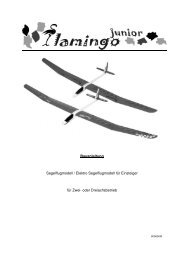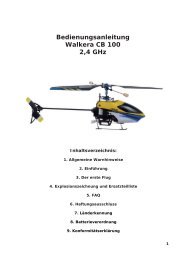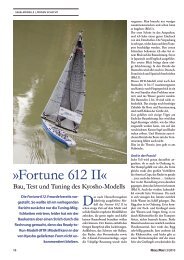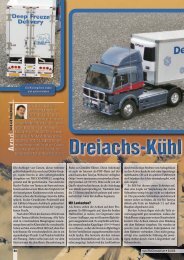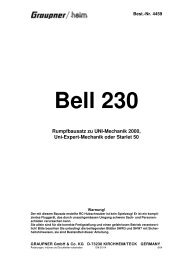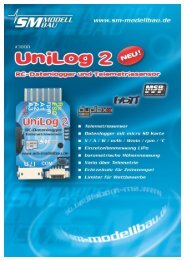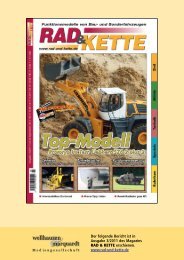Zweitakt-Benzinmotor RCGF 45 - RC-Toy
Zweitakt-Benzinmotor RCGF 45 - RC-Toy
Zweitakt-Benzinmotor RCGF 45 - RC-Toy
Create successful ePaper yourself
Turn your PDF publications into a flip-book with our unique Google optimized e-Paper software.
Operating Instructions<br />
<strong><strong>RC</strong>GF</strong> <strong>45</strong> two-stroke petrol engine<br />
Specification<br />
Capacity:<br />
Bore x stroke:<br />
Power:<br />
Speed range:<br />
Weight:<br />
Ignition:<br />
Ignition battery:<br />
Propeller:<br />
<strong>45</strong> cc<br />
43 x 31 mm<br />
4.3 bhp, 3.0 kW<br />
approx. 1500 – 7600 rpm<br />
approx. 1610 g incl. silencer<br />
and ignition unit<br />
electronic<br />
4.8 - 6 V<br />
20 x 8” (approx. 8000 rpm)<br />
20 x 10” (approx. 7600 rpm)<br />
22 x 8” (approx. 7500 rpm)<br />
Connect the throttle servo and check from the transmitter that<br />
it works correctly.<br />
“Z”<br />
“A”<br />
Introduction<br />
The <strong><strong>RC</strong>GF</strong> <strong>45</strong> petrol engine works on the two-stroke principle.<br />
This means that the gas exchange process within the engine<br />
occurs through slots, or ports, in the cylinder, and each full<br />
rotation of the crankshaft acts as a working stroke.<br />
The fuel mixture is ignited by an electronic ignition system<br />
powered by a 4.8 V battery. In contrast to glowplug motors, a<br />
constant voltage must be present for the engine to run.<br />
Suitable fuel<br />
Use normal two-stroke petrol / oil mixture (mix ratio 1 : 50). It<br />
is essential to use a high-quality synthetic lubricating oil.<br />
No special fuel mix is required for running-in.<br />
Silencer<br />
Use the silencer and exhaust manifold supplied with the engine.<br />
Safety notes<br />
Do not allow petrol to contact your skin, eyes or nose. If this<br />
should occur accidentally, wash the affected area immediately<br />
using plenty of cold water. Do not breathe in petrol fumes.<br />
The engine must only be run outdoors, or in a room with a suitable<br />
forced ventilation system.<br />
Keep well clear of the rotational plane of the propeller - injury<br />
hazard.<br />
You will need the following items to operate the petrol<br />
engine:<br />
- Propeller (see Specification for recommended sizes)<br />
- Fuel mixture<br />
- Fueltank (approx. 500 cc) and petrol-proof fuel tubing<br />
- 4.8 V ignition battery, min. capacity 1200 mAh<br />
- Switch harness for interrupting the ignition current<br />
Installation, running-in procedure, running-in time<br />
The engine should be run-in whilst mounted directly in the<br />
model. Install the power plant, fueltank and fuel tubing in<br />
accordance with the kit instructions.<br />
Install the ignition unit and its power supply: push the plug<br />
cap onto the sparkplug, and connect the sensor “Z” to the<br />
electronic unit “E”.<br />
Connect battery “A” to the electronics using the switch harness<br />
“S”. Secure the ignition battery and electronics.<br />
“S”<br />
Select the appropriate propeller, drill additional holes in the<br />
hub if necessary to match those in the prop washer, and fit it<br />
on the engine shaft. The propeller should be mounted in such<br />
a way that one tip is angled slightly to the right of vertical<br />
when the piston is at top dead centre (TDC).<br />
Never attempt to hold the crankshaft immobile by inserting a<br />
screwdriver or similar tool in the exhaust port while you tighten<br />
the propeller, as this would immediately ruin the piston<br />
and cylinder liner.<br />
Check that the engine is securely mounted in the model.<br />
Ensure that the propeller is firmly attached to the crankshaft.<br />
Install the silencer and connect the fuel lines.<br />
The engine requires about ten hours of running-in to free up<br />
completely. The first tankful of fuel should be run through the<br />
engine on the ground. The model can then be flown during<br />
the remainder of the running-in period, keeping the mixture<br />
rich all the time. During this initial period avoid operating the<br />
engine at full-throttle for long periods.<br />
The carburettor<br />
The carburettor is correctly set at the factory, and should not<br />
be adjusted unless absolutely necessary.<br />
The carburettor controls<br />
- 1 Choke<br />
- 2 Throttle lever (throttle pushrod connection point)<br />
- 3 Idle stop-screw<br />
- 4 Idle needle<br />
- 5 Main needle<br />
Running the engine for the first time<br />
“E”<br />
Caution: if you intend to start the engine by hand, a thick<br />
glove must be worn to reduce the risk of injury. Secure<br />
the model carefully, so that there is no chance of it rolling<br />
away accidentally.<br />
© robbe Modellsport<br />
3



